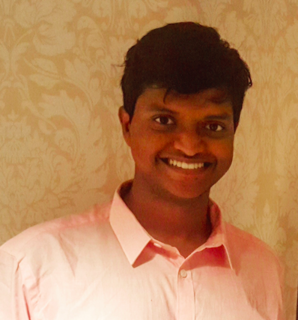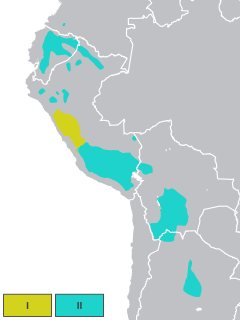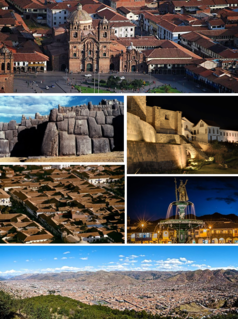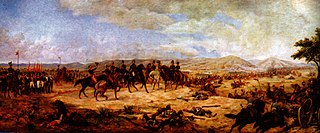Biography
The documentation on the life of Micaela Bastidas in not ample in comparison to that of her husband, but the historical record documents her birth, marriage, and death. [3] Micaela was born in Pampamarca province of Canas (laqaymarca annexed iromocco community of Pabellones, of the district of Pampamarca, of the province of Canas in 1744. She was the natural daughter of Manuel Bastidas (d. 1746) (perhaps of African descent or a priest) and Josefa Puyucahua Sisa. Given her status as an illegitimate child perhaps either of a priest or a black, she was marginalized in the overwhelmingly indigenous Andean highlands. Micaela spoke Quechua better than Spanish. She was a devout Catholic, but had little formal schooling. [4] An account describes her as being "a beautiful Indian girl." [5] It is unclear whether she was of African descent, since virtually nothing is known about her father, but some documents refer to her as a Zamba, a name given during the colonial-era racial hierarchy for those of mixed race, African and indigenous. Her marriage certificate listed her parents as both being "Spaniards" (españoles), but there was considerable fluidity in the system of racial classification, and such a designation may have been a "sign of respectability." [6]

Zambo and cafuzo are racial terms used in the Casta caste class system of the Spanish and Portuguese empires and occasionally today to identify individuals in the Americas who are of mixed African and Amerindian ancestry. Historically, the racial cross between enslaved African and Amerindians was referred to as a zambayga, then zambo, then sambo. In the United States, the word sambo is thought to refer to the racial cross between an enslaved African and a white person.

Multiracial is defined as made up of or relating to people of many races. Many terms exist for people of various multiracial backgrounds. Preferred terms include mixed race, multiracial, biracial, multiethnic, polyethnic, half, half-and-half, Mixed blood, Métis, Creole, Dougla, mestizo, mulatto, Melungeon, Criollo, quadroon, zambo, Eurasian, hapa, hāfu, garifuna and pardo. Some of the terms are considered insulting and offensive.
On May 25, 1760, before her sixteenth birthday, Micaela married José Gabriel Condorcanqui, who later used the name Túpac Amaru II, in the church of Our Lady of Purification in the city of Surimana. José Gabriel was a young mixed-race descendant of an important figure in Peruvian history, of the Inca Tupac Amaru I, executed by the Spanish in 1572. In 1764, he was named the cacique or kuraka of the territories corresponding with his legacy: Pampamarca, Tungasuca, and Surimana. The title and perquisites of power was hereditary. He fixed his residency with Micaela in Tinta, a region of Cusco. The couple produced three sons, Hipólito (1761), Mariano (1762), and Fernando (1768), baptized by the same priest that married them. [7]

José Gabriel Túpac Amaru — known as Túpac Amaru II — was the leader of a large Andean uprising against the Spanish in Peru, whose quelling resulted in his death. He later became a mythical figure in the Peruvian struggle for independence and indigenous rights movement, as well as an inspiration to myriad causes in Spanish America and beyond.

Surimana is a mountain in the Wansu mountain range in the Andes of Peru, about 5,200 metres (17,060 ft) high. It is situated in the Cusco Region, Chumbivilcas Province, Santo Tomás District. Surimana lies northwest of Qullpa K'uchu and Minasniyuq.
The history of Peru spans 4 millennia, extending back through several stages of cultural development in the mountain region and the lakes. Peru was home to the Norte Chico civilization, the oldest civilization in the Americas and one of the six oldest in the world, and to the Inca Empire, the largest and most advanced state in Pre-Columbian America. It was conquered by the Spanish Empire in the 16th century, which established a Viceroyalty with jurisdiction over most of its South American domains. The nation declared independence from Spain in 1821, but consolidated only after the Battle of Ayacucho, three years later.
José Gabriel had received a privileged education in the school of Jesuits in Lima and Cusco at a school for the sons of indigenous lords. He spoke and wrote Spanish, spoke Quechua, and knew some Latin from his Jesuit education. He was the owner of large extensions of land and riches, having many roles of administration of their property. As a chief, he would mediate between the chief magistrate and indigenous people and their crime charges. As he prospered, he saw how the rest of the population was affected due to the physical revolts and creation of internal customs. As a regional trader over an extensive network, with 350 mules to carry trade-goods, he was in an excellent position to forge relationships with those he traded with and gather information about local conditions and concerns. As a person of mixed roots, he felt that he touched all of the injustice with his people firsthand. He came up with strategies and official applications to the authorities of Tinta, Cusco and Lima so that indigenous people were freed from obligatory work in the mines and were exonerated with compliance of forced labor. He always got negativity and indifference, but began to develop a libertarian ideology based on the defense of indigenous people, slaves, creoles, and people of mixed races, while guiding the independence of the territory and commerce from the decisions of the crown of Spain.

Lima is the capital and the largest city of Peru. It is located in the valleys of the Chillón, Rímac and Lurín rivers, in the central coastal part of the country, overlooking the Pacific Ocean. Together with the seaport of Callao, it forms a contiguous urban area known as the Lima Metropolitan Area. With a population of more than 9 million, Lima is the most populous metropolitan area of Peru and the third-largest city in the Americas, behind São Paulo and Mexico City.

Spanish or Castilian is a Romance language that originated in the Castile region of Spain and today has hundreds of millions of native speakers in the Americas and Spain. It is a global language and the world's second-most spoken native language, after Mandarin Chinese.

Quechua, usually called Runasimi in Quechuan languages, is an indigenous language family spoken by the Quechua peoples, primarily living in the Peruvian Andes and highlands of South America. Derived from a common ancestral language, it is the most widely spoken language family of indigenous peoples of the Americas, with a total of probably some 8–10 million speakers. Approximately 25% of Peruvians speak a Quechuan language. It is perhaps most widely known for being the main language family of the Inca Empire. The Spanish colonisers initially encouraged its use, but from the middle of their reign they suppressed it. However, Quechua ultimately survived and variants are still widely spoken today.
The marriage was a happy one and a full partnership. An important series of letters in Spanish exchanged between them during the early period of the rebellion include endearments and pet names for each other, as well as concerns about the other's safety. [8]
After that she was captured in a failed uprising. She had joined her spouse in leading the rebellion, leading indigenous men and women in a battle for independence as well as organizing supplies and recruiting forces. [9]
She was executed by the Spanish very painfully on May 18, 1781, at 36 years of age. The Spanish attempted to use a hand-cranked garrote on her that had been designed for the occasion and first used on fellow rebel Tomasa Tito Condemayta, but because her neck was so slender she was instead strangled with a rope. [6] Her son Hipólito was also executed by the Spanish, both of them in front of Tupac Amaru II, who himself was then quartered and beheaded by the Spanish.




















